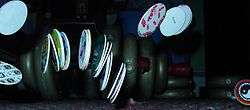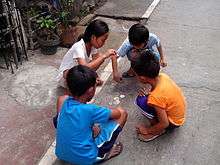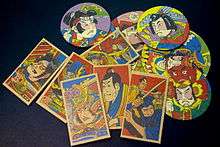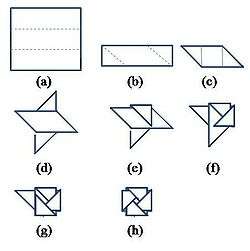Milk caps (game)
| Other name(s) |
|
|---|
Pogs, generically Milk caps, is a game that was popular among children during the early-mid 1990s.
The brand name "Pog" is owned by the World Pog Federation. The name pog originates from POG, a brand of juice made from passionfruit, orange, and guava; the use of POG bottle caps to play the game preceded the game's commercialization.[1]
History
The game of milk caps possibly originated in Hawaii (Maui) in the 1920s or 1930s,[2][3] or possibly with origins in Menko, a Japanese card game very similar to milk caps, which has been in existence since the 17th century.[4] The game of milk caps was played on the Hawaiian island of Maui as early as 1927.[5][6][7] There are caps that collectors have dating to the 1940s and 1950s.[8]
Haleakala Dairy of Maui sold a mixed fruit drink in a glass bottle with a cap under the brand name of POG. In 1955, Haleakala discontinued using the glass containers, but continued making the caps to allow the game to be played.[8] Orchards Hawaii also continued to make milk caps after having stopped using glass bottles.[9] In 1991, Haleakala expanded to the larger Oahu island, which led to a revival of the game. With this revival, the Pog name began being used generically for the game.[8]
The 1990s revival is credited to Blossom Galbiso, a teacher and guidance counselor who taught at Waialua Elementary School in Oahu. In 1991, Galbiso introduced the game she had played as a little girl to a new generation of students, soon incorporating milk caps into her fifth grade curriculum as a way of teaching math and as a nonviolent alternative to other popular schoolyard games, such as dodgeball.[5] The game quickly spread from Oahu's North Shore, and by early 1992, STANPAC Inc., the small Canadian packaging company that had been manufacturing the milk caps distributed by Haleakala Dairy on Maui (the same caps that were collected by Galbiso for her class), was printing millions of milk caps every week for shipment to the Hawaiian island chain. The game soon spread to the mainland, first surfacing in California, Texas, Oregon, and Washington before spreading to the rest of the country. By 1993, the previously obscure game of milk caps, which had almost been forgotten, was now played throughout the world.[10]

Milk caps returned to popularity when the World POG Federation and the Canada Games Company reintroduced them under the Pog brand name in the 1990s. The Pog fad soared, and peaked in the mid-1990s.[11][12] Pogs were being handed out for opening bank accounts and in McDonald's Happy Meals.[8]
Seven other companies entered the milk cap field after a comic book and card industry convention in January 1993. SkyBox International and Marvel added the product to their lines under the names SkyCaps and Hero Caps respectively.[8] The game had spread to California, Florida and Texas.[9]
The term Pog was claimed as trademark by the World Pog Federation while other companies claimed it was generic term as it was selected by the children that played the game. Mean and at times violent arguments occurred at flea markets, swap meets and trade shows over the issue. In October 1994, a lawsuit was settled between World Pog and Universal Pogs Association. Pog was recognized as World Pog's exclusive term and Universal Pogs changed its name to Universal Slammers, Inc.[9]
Because many children would keep the milk caps they won in games from other players, many school districts considered milk caps a form of gambling.[4][13] Milk caps proved to be major distractions from classes and the source of various playground arguments. These elements eventually led to the banning of milk caps from various schools across North America.[13][14] Other bannings occurred across Australia.[15]
Equipment
Milk caps typically relies on two types of playing discs: milk caps and slammers. Milk caps are typically flat circular cardboard discs which are decorated with images on one or both sides. Traditional (or traditional-style) milk caps are made of rougher cardboard, are printed with limited colors, and often have a staple in them (as they appeared when used as actual POG bottlecaps), while modern commercial pogs were stiffer, thicker and are often printed with colorful glossy imagery.
The other equipment that is used is a slammer: a heavier game piece often made of metal, rubber, or more commonly plastic which come in various thicknesses and weights,[4] but are typically similar in diameter to milk caps. Metal slammers are not allowed in some games because they are typically heavier than other materials, giving the player with the first turn an unfair advantage.
Gameplay

Rules vary among players, but the game variants generally have common gameplay features. Each player has his/her own collection of milk caps and one or more slammers. Before the game, players decide whether to play "for keeps", or not. "For keeps" implies that the players keep the milk caps that they win during the game and forfeit those that have been won by other players. The game can then begin as follows:
- The players each contribute an equal number of milk caps to build a stack with the pieces face-down, which will be used during the game.[4]
- The players take turns throwing their slammer down onto the top of the stack, causing it to spring up and the milk caps to scatter. Each player keeps any milk caps that land face-up after they've thrown.[4][16]
- After each throw, the milk caps which have landed face-down are then re-stacked for the next player.
- When no milk caps remain in the stack, the player with the most pogs is the winner.[4]
World POG Federation
The World POG Federation was the licensed POG publisher, which was 14% owned by Haleakala Dairy, the trademark holder of POGs. Federation president in 1994 was Alan Rypinski. The company was based in Costa Mesa, California.[9]
Military uses
The Army and Air Force Exchange Service, the United States Department of Defense's largest and oldest exchange system, distributes milk-cap-like coinage as change at its stores in contingency areas (those supporting Operations Enduring Freedom and Iraqi Freedom).[17] The reason for adopting milk caps as currency was that supply flights overseas had limited capacity and air-freight shipping involved high costs.[2] Metal coinage weighs significantly more than paper milk caps, which are also much thinner than standard milk caps. While they are only issued in contingency areas, they are redeemable at any AAFES store worldwide.[17]
Country overview

Japan
Menko (めんこ, 面子) is a Japanese card game played by two or more players, dating back to the 17th century. Each player uses Menko cards made from thick paper or cardboard, printed on one or both sides with images from anime, manga, and other works.
South Korea

The card used in Ttakji/Ddakji (딱지) is constructed by folding two square pieces of paper together into a square. As with milk caps, the game is won by flipping the other player's card. The popular Korean variety show Running Man occasionally features ddakji in their missions, which may contribute to the awareness of the game in other parts of the world.[18][19]
See also
- Tazos were also popular in the UK and Australia - these were effectively milk caps with notches along their circumference which meant they could be connected together and used to construct rudimentary 3D shapes. They were given away free in packets of Walkers Crisps and usually featured licensed properties - notably scenes from Star Wars, Looney Tunes and Pokémon.
- Bachicombat
References
- ↑ Lewis, Tommi: "Pogs: The Milkcap Guide", page 23. Andrews and McMeel, 1994
- 1 2 "POGs -- dollars, cents of setting up shop in a war zone". Air Force Print News Today. 2005-06-06. Retrieved 2007-02-17.
- ↑ "POG Is Back!; Funrise Heads to Hawaii Where It All Began to Re-Introduce the International Collectible Craze of the 90s". Business Wire. 2005-12-05. Retrieved 2007-02-17.
- 1 2 3 4 5 6 "Flipping out pogs are popping up everywhere as the game that is sweeping through the nation catches on with South Hampton Roads youngsters". The Virginian Pilot. Landmark Communications, Inc.). 1995-03-07. Archived from the original on 2007-10-16. Retrieved 2007-02-17.
- 1 2 Essoyan, Susan (June 7, 1993). "New wave of 'pog' mania crests over Hawaii". Los Angeles Times. Retrieved 2 July 2010.
- ↑ Rothman, Jason (November 2, 1994). "POG is newest kids' fad". Palo Alto Online. Retrieved 2 July 2010.
- ↑ "Blossom Galbiso". The Baltimore Sun. December 31, 1994. Retrieved 2 July 2010.
- 1 2 3 4 5 "Will Cardboard Caps From Milk Bottles Become Cream Of All". Hartford Courant. 1993-07-26. Retrieved 2016-06-03.
- 1 2 3 4 "Agreement Puts an End To 'Pog' Trademark War". The New York Times. November 9, 1994. Retrieved November 22, 2016.
- ↑ Imperiale, Nancy (March 15, 1994). "It Was Hot In Hawaii, It's Ho-hum Here". Orlando Sentinel. Retrieved 2 July 2010.
- ↑ DeMasters, Tiffany. "90s pog fad still has a few die-hard fans", Deseret News, July 11, 2006. Accessed July 29, 2009.
- ↑ Angilly, Paul. "There was some good, some bad from 1993", The New Britain Herald, December 31, 2003. Accessed July 29, 2009.
- 1 2 "Milking the MK Craze". GamePro. IDG (68): 154–155. March 1995.
- ↑ "If You Can't Beat 'Em, Ban 'Em". Stay Free! (13). April 1997.
- ↑ Pogs: The Milkcap Guide, "invented by Laura Donahue" chapter 7. Andrews and McMeel, 1994
- ↑ "How to Play pogs". Retrieved 2007-02-17.
- 1 2 "Why pogs and not legal tender?" (website). Stars and Stripes (Pacific Edition). 2007-02-06. Retrieved 2007-02-17.
- ↑ Talty, Stephan (2015). Under the Same Sky: From Starvation in North Korea to Salvation in America. Houghton Mifflin Harcourt. p. 10. ISBN 0544373170. Retrieved 3 February 2016.
- ↑ Yi, I-hwa (2006). Korea's Pastimes and Customs: A Social History. Homa & Sekey Books. p. 58. ISBN 1931907382. Retrieved 3 February 2016.
External links
- spakatak.com International Tazos Guide
- Reference site for AAFES pogs, with image galleries
- Information and images of pogs, tazos, flippos and other milkcaps
- Professional Organization of Poggz